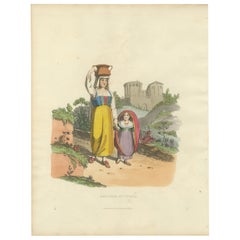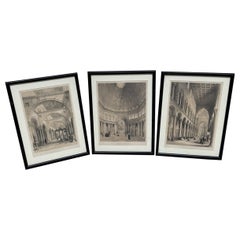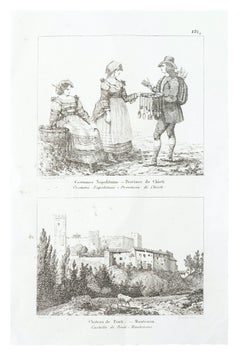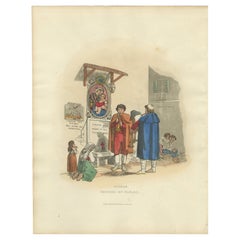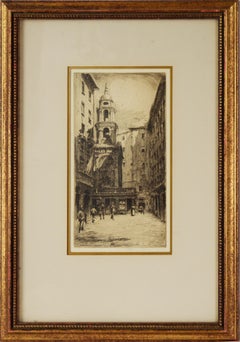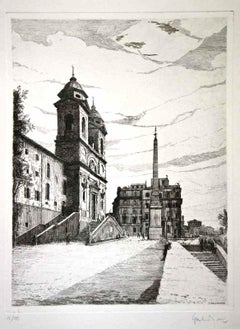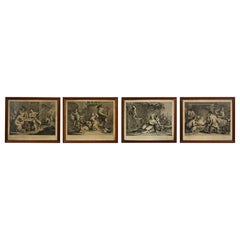Etchings Of Italy
to
9
78
41
53
36
32
23
20
14
12
9
9
9
8
7
6
6
5
5
4
4
3
3
3
2
2
2
2
2
2
1
1
1
1
1
1
1
1
1
9
9
7
4
4
Sort By
Tivoli Costumes & Temple of Vesta - 1819 Etching of Italian Heritage
Located in Langweer, NL
Title: Tivoli Costumes & Temple of Vesta - 1819 Etching of Italian Heritage
Description: This
Category
Antique 1820s Prints
Materials
Paper
$189
H 12.45 in W 9.45 in D 0.01 in
1960s Set of 3 Italian Architectural Etchings
Located in Chula Vista, CA
1960s Set of 3 Italian Architectural Etchings
Signed hard to read
20.5 x 15.75 x .75 Art 16 x 12
Category
Vintage 1960s Italian Mid-Century Modern Drawings
Materials
Paper, Glass
Scenes of Everyday Life in italy - Etching - 19th Century
Located in Roma, IT
Italian Landscape is an original print on paper, includes two images in one sheet, realized by an
Category
19th Century Figurative Prints
Materials
Etching
$237
H 8.67 in W 5.71 in D 0.08 in
Neapolitan Pilgrims Etching - 1819 Pinelli & Bridgens Print
Located in Langweer, NL
Pinelli (1781–1835), born in Rome, was renowned for his detailed etchings of Italian life, often focusing
Category
Antique 1810s Prints
Materials
Paper
Church of San Pietro In Banchi, Italy - 1908 Original Etching
Located in Soquel, CA
Church of San Pietro In Banchi, Italy - 1908 Original Etching
Original 1908 etching of the church
Category
Early 1900s Post-Impressionist Landscape Prints
Materials
Laid Paper, Etching
$950
H 17.75 in W 12.25 in D 1 in
Italy : The Palms Of Naples - Original etching, 1959 (Reims #340)
By Bernard Buffet
Located in Paris, IDF
Bernard Buffet (1928-1999)
The Palms Of Naples
Original drypoint etching
On vellum 38 x 28 cm
Category
1950s Modern Landscape Prints
Materials
Etching
$237
H 14.97 in W 11.03 in
Black and white Italian countryside etching made by the leader of print in Italy
By Federica Galli
Located in Milan, IT
Cascina Madera,
Ref. 421
Original etching, signed and numbered. Limited edition of 90.
Federica
Category
1980s Realist Landscape Prints
Materials
Etching
Federica GalliBlack and white Italian countryside etching made by the leader of print in Italy, 1981
$617 Sale Price
20% Off
H 9.77 in W 19.41 in
View of Trinità dé Monti (Rome, Italy) - Original Etching by G. Malandrino
By Giuseppe Malandrino
Located in Roma, IT
Edition of 199 prints, numbered and hand signed.
Very good conditions.
Category
1970s Landscape Prints
Materials
Etching
Giuseppe MalandrinoView of Trinità dé Monti (Rome, Italy) - Original Etching by G. Malandrino, 1970s
$308
H 27.76 in W 19.49 in D 0.04 in
18h Century, Four Italian Etching Allegory of the Four Seasons
By Giovanni Volpato 1
Located in IT
18h Century, Four Italian Etching Allegory of the Four Seasons
Allegory of the Four Seasons
Category
Antique 1770s Italian Neoclassical Prints
Materials
Canvas, Walnut, Paper
Allegory of Spring - Etching from Louvre Museum
By Sandro Botticelli
Located in Paris, IDF
Sandro Botticelli
Allegory of Spring
Etching
Not signed
On vellum 57 x 76 cm (c. 22.45 x 29.93
Category
Mid-20th Century Italian School Portrait Prints
Materials
Etching
Map of Italy - Etching by Pierre François Tardieu - 1837
Located in Roma, IT
Map of Italy is an Etching realized in 1837.
Good conditions.
The artwork is realized in a well
Category
1830s Modern Figurative Prints
Materials
Lithograph
$356
H 11.03 in W 8.47 in D 0.04 in
John Marin "Clock Tower of Santa Maria Zobenigo, Venice, Italy" Etching c.1907
By John Marin
Located in San Francisco, CA
John Marin "Clock Tower of Santa Maria Zobenigo, Venice, Italy" Original Pencil Signed Etching c
Category
Early 20th Century Impressionist Landscape Prints
Materials
Etching
$1,500
H 15 in W 11.5 in D 1 in
Impressive Colored Etching Venice Italy Doges Palace manner of Canaletto, Signed
By Giovanni Antonio Canal (Canaletto)
Located in Miami, FL
Colored Etching Venice Italy Doges Palace,
Colored Etching manner of Canaletto by Hungarian Artist
Category
Early 20th Century Hungarian Art Deco Decorative Art
Materials
Paper
$1,150
H 17 in W 12 in D 1 in
Neoclassical Roman Views Set of Two Italian Etchings Salmon Albrizzi Venice 1751
By Giambattista Albrizzi
Located in Milano, MI
A pair of Rome views, two Neoclassical original etchings depicting Italian views of Rome, with the
Category
Antique Mid-18th Century Italian Neoclassical Prints
Materials
Paper, Wood
$830 / set
H 15.75 in W 17.72 in D 0.79 in
Portrait of Isabella d'Este - Etching from Louvre Museum
By Leonardo da Vinci
Located in Paris, IDF
Leonardo DA VINCI
Portrait of Isabella d'Este
Etching
Not signed
On vellum 81 x 59 cm (c. 31.89 x
Category
Mid-20th Century Italian School Portrait Prints
Materials
Etching
Set of Four Grand Tour Etchings Italian Architectural Views Remondini circa 1770
Located in Milano, MI
A late-18th century Italian hand-colored copper engravings, original Italian etchings by Remondini
Category
Antique Late 18th Century Italian Grand Tour Prints
Materials
Wood, Paper
$3,560
H 14.97 in W 20.08 in D 0.79 in
Pair 18th Century Framed Italian Etchings of Churches in Rome by Guiseppe Vasi
Located in Stamford, CT
Pair of 18th century Italian architectural etchings of churches in Rome by Guiseppe Vasi (1710-1782
Category
Antique Mid-18th Century Italian Neoclassical Prints
Materials
Paper
$1,880
H 16.75 in W 21.25 in D 0.75 in
Set of Four Roman Etchings
Located in Los Angeles, CA
Set of four Roman etchings with soldiers on horses and horses with their caretakers.
Category
Vintage 1920s Italian Other Paintings
Materials
Other
Italian Antique Picture Etching Print of a Street Seller in Wooden Frame, 1800s
Located in MIlano, IT
Italian antique Picture of etching print of a street seller in wooden frame, 1800s
Print made with
Category
Antique 19th Century Italian Prints
Materials
Wood, Paper
$415
H 14.97 in W 11.03 in D 0.79 in
Impressions of Italy - Italian Views
By Edgar Chahine
Located in London, GB
This complete set of fifty etchings, aquatints and drypoints are each hand signed by the artist
Category
Early 1900s Landscape Prints
Materials
Drypoint, Etching, Aquatint
Triptych of Three Monumental Etchings by Mimmo Paladino
By Mimmo Paladino
Located in Long Island City, NY
A set of three monumental etchings by Italian contemporary artist, Mimmo Paladino. Each nicely
Category
1990s Abstract Expressionist Abstract Prints
Materials
Gold Leaf
Framed Etching of Vases by Giovanni Piranesi
Located in Bradenton, FL
The dramatic large, almost 4 foot tall etching is framed with a green ground and gold double border
Category
Antique 19th Century Italian Renaissance Prints
Materials
Paper
1935 Laurenzio Laurenzi Acqua Forte Etching of Venezia
Located in Florence, Tuscany
A beautiful acqua forte black and white signed etching of Venice. This wonderful piece was created
Category
Vintage 1930s Italian Prints
Materials
Wood, Paper
Suite of 12 Views of Italy
By Franz Weirotter
Located in New York, NY
Franz Weirotter (1730-1771), Suite of 12 Views of Italy, etchings, 1759 [most signed in the plate
Category
1750s Old Masters Landscape Prints
Materials
Etching
Impressive Collection of 8 Antique Etchings Portraits of Roman Leaders
Located in Hopewell, NJ
Beautiful & rare collection of 8 antique Italian etchings that are stately portaits of famous Roman
Category
Antique 19th Century Italian Prints
Materials
Paper
$4,950 / set
H 16.75 in W 12.75 in D 1 in
Pair of Ettore Fagiuoli framed signed etchings of Venice and Verona
Located in Atlanta, GA
A pair of signed etchings dated 1926 by Italian artist Ettore Fagiuoli. Beautifully matted in off
Category
Vintage 1920s Italian International Style Drawings
Materials
Paper
$2,300 / set
H 26.5 in W 20 in D 1 in
Framed Antique Etching of Ship by Piranesi
By Giovanni Battista Piranesi
Located in New York, NY
Plate #106 from Giovanni Battista Piranesi's Vasi, candelabri, cippi, sarcofagi, tripodi, lucerne, ed ornamenti antichi disegnati ed incisi dal Cav. Gio. Batt. Piranesi, Vol. I (Vase...
Category
Antique 19th Century Italian Prints
Materials
Paper
View of Florence Acqua Forte Etching, Parchment Picture, 1850s
Located in Florence, Tuscany
A truly wonderful Acqua forte etching showing a view of Florence etched in the 1850s. The view
Category
Antique 19th Century Italian Prints
Materials
Paper
Pair of Venice Etchings by N Erichsen 1904
Located in Dallas, TX
Presenting a lovely pair of Venice etchings by N Erichsen 1904.
This pair of etchings were drawn
Category
Early 20th Century Italian Edwardian Prints
Materials
Paper
Framed Etching of Ornamental Candelabrum Base by Giovanni Piranesi
Located in Bradenton, FL
Framed etching of ornamental candelabrum base found in the courtyard of a church in Italy (Sant
Category
Antique 19th Century Italian Renaissance Prints
Materials
Paper
17th Century Francesco Curti "Vendor of Shoes" Etching
By Giuseppe Maria Mitelli, Francesco Curti
Located in Cagliari, IT
The print is part of the series consisting of forty engravings, "I mestieri per la via" (The crafts on the road), engraved by Francesco Curti (Bologna ca.1603- Bologna 1670) by an in...
Category
Antique 1660s Italian Prints
Materials
Copper
$189 Sale Price
50% Off
H 15.16 in W 18.51 in D 0.79 in
Italian landscape of typical lombard architecture by master italian etcher
By Federica Galli
Located in Milan, IT
Cascina (Farmhouse) Santo Stefano, rif. 490
Original etching, signed and numbered. Limited
Category
1980s Realist Landscape Prints
Materials
Etching
$1,424
H 25.01 in W 13.67 in
Neoclassical Etching of Roman Candelabra by Giovanni Battista Piranesi
By Giovanni Battista Piranesi
Located in Stamford, CT
Neoclassical Etching of three ancient Roman candelabra by Giovanni Battista Piranesi (1720-1778
Category
Antique Late 18th Century Italian Neoclassical Prints
Materials
Paper
$1,130
H 38.5 in W 29 in D 0.75 in
Forum of Minerva, Assisi, Italy
By William Walcot R. E. Hon. R. I. B. A.
Located in Middletown, NY
Etching with aquatint on watermarked F J Head & Co. cream laid paper, 9 3/4 x 11 1/2 inches (245 x
Category
Early 20th Century Modern Landscape Prints
Materials
Laid Paper, Etching, Aquatint
Framed Etching of a Massive Urn by Piranesi, Plate 549
By Giovanni Battista Piranesi, Francesco Piranesi
Located in Downingtown, PA
Large framed etching of a massive urn
Francesco Piranesi in the style of his father, Giovanni
Category
Antique Early 19th Century Italian Georgian Prints
Materials
Paper
Neoclassical Etching of a Roman Candelabrum by Giovanni Battista Piranesi
By Giovanni Battista Piranesi
Located in Stamford, CT
Neoclassical Etching of three ancient Roman urn on pedestal, two oil lamps and a vase by Giovanni
Category
Antique Late 18th Century Italian Neoclassical Prints
Materials
Paper
$1,130
H 38.5 in W 29 in D 0.75 in
Early Nineteenth Century Colored Etching of a Wall in Pompeii
Located in San Francisco, CA
floor, frescoed wall of a house in Pompeii. Engraved by Francesco Morelli (1767-1830) a French-Italian
Category
Antique Early 19th Century Italian Neoclassical Prints
Materials
Paper
Étienne Dupérac Etchings of Ancient Roman Ruins, 17th Century - A Pair
Located in Savannah, GA
Étienne Dupérac
(French, 1535-1604)
A pair of etchings from I vestigi dell'antichita di Roma
Category
Antique 17th Century Italian Classical Roman Prints
Materials
Paper
$1,600 / set
H 15 in W 18.5 in D 1.25 in
Fishing the swordfish - Sea of South Italy
By Giovanni Omiccioli
Located in Roma, IT
Hand signed. Edition of 10 prints, in Roman Numerals.
Image Dimensions : 11 x 17 cm
Passepartout included : 37.5 x 52.5 cm
Category
1970s Modern Figurative Prints
Materials
Etching
$415
H 9.85 in W 13.78 in D 0.08 in
Washington At Pohick Church - 1932 Etching On Paper
By Ernest David Roth
Located in Soquel, CA
his paintings and etchings of scenes of New York, Italy (especially Venice), and Spain. He studied
Category
1930s American Impressionist Landscape Prints
Materials
Laid Paper, Etching
$720 Sale Price
20% Off
H 16 in W 20 in D 0.5 in
Giovanni Antonio Canal 'Canaletto' Etching of Prato Della, Venice, 1697-1768
By Giovanni Antonio Canal (Canaletto)
Located in Oklahoma City, OK
Lovely etching on paper in back ink by Giovanni Antonio Canal (Canaletto).
Measurements:
22" x
Category
Antique 18th Century Italian Rococo Prints
Materials
Paper
$3,480 Sale Price
20% Off
H 15 in W 22 in D 0.01 in
Peggy /// Antique Victorian Etching Portrait Figurative British Children Child
By Sidney Tushingham
Located in Saint Augustine, FL
society painter. He also became known for his etchings of pre-war Britain, Italy and Spain. He died in
Category
1920s Modern Portrait Prints
Materials
Laid Paper, Drypoint, Etching, Intaglio
Molly /// Antique Victorian Etching Portrait Figurative British Children Child
By Sidney Tushingham
Located in Saint Augustine, FL
society painter. He also became known for his etchings of pre-war Britain, Italy and Spain. He died in
Category
1920s Modern Portrait Prints
Materials
Laid Paper, Drypoint, Etching, Intaglio
Romantic snowy landscape of Italy 's countryside vertical view, limited print
By Federica Galli
Located in Milan, IT
Cascina Bellaria, Milan's countryside, catalogue rif. 497
Original etching, signed and numbered
Category
1980s Realist Landscape Prints
Materials
Etching
$1,424
H 25.32 in W 13.55 in
Pair of contemporary Venice views. Prints by F. Galli, Italian etcher.
By Federica Galli
Located in Milan, IT
Here we propose a pair of etchings by Federica Galli, whose size, subjects and composition form a
Category
20th Century Contemporary Landscape Prints
Materials
Etching
$3,441
H 11.58 in W 31.19 in D 1.19 in
circa 1900 Sir Claude Francis Barry Aquatint Etching of a Ballet Dancer in Swan
By Sir Claude Francis Barry
Located in Biella, IT
Sir Claude Francis Barry ballet dancer swan lake, aquatint etching hand signed years '900 perfect
Category
Antique Early 1900s Italian Art Nouveau Prints
Materials
Paper
$5,933
H 24 in W 0.4 in D 18 in
Old farmhouse in the surrounding countryside of Milan etched by italian engraver
By Federica Galli
Located in Milan, IT
Cascina Riazzolo,
Ref. 401
Original etching, signed and numbered. Limited edition of 90.
Federica
Category
1980s Realist Landscape Prints
Materials
Etching
Federica GalliOld farmhouse in the surrounding countryside of Milan etched by italian engraver, 1980
$759 Sale Price
20% Off
H 13.78 in W 25.08 in
Venice view print, with the sharp contemporary gaze of an Italian artist
By Federica Galli
Located in Milan, IT
Rio dei Furlani (ref. cat. 534). The etching was exhibited last year in the significant
Category
20th Century Contemporary Landscape Prints
Materials
Etching
$1,542
H 27.25 in W 11.38 in D 1.19 in
Portrait de Femme (Portrait of a Woman) /// Old Masters Italian Romantic Queen
Located in Saint Augustine, FL
is after a painting by Italian artist Bernardino Luini (1480-1532).
This etching and aquatint was
Category
1890s Old Masters Portrait Prints
Materials
Etching, Aquatint, Intaglio
Column of Antoninus Pius, Rome Italy. Jacobs Lauro 17th century engraving
Located in Melbourne, Victoria
Lauro produced a series of engravings of the ancient monuments of Classical Rome with detailed descriptions in Latin below.
180mm by 240mm (plate mark)
240mm by 345mm (sheet)
Category
Early 17th Century Old Masters Landscape Prints
Materials
Engraving, Etching
$240
H 9.45 in W 13.59 in
Neoclassical Etching A Roman Corinthian Capital by Francesco Piranesi
By Francesco Piranesi
Located in Stamford, CT
(Italian, 1758 - 1810). Architectural Etching on paper. Signed in plate lower right. In very good
Category
Antique Late 18th Century Italian Neoclassical Prints
Materials
Paper
$790
H 38.5 in W 29 in D 0.75 in
Antique Raffaello Hand Colored Lithograph Etching in Gilt Frame
Located in Haddonfield, NJ
Impressive Italian hand-colored classic motif print depicting lions, birds, griffins, swans, ruins
Category
Mid-20th Century Italian Neoclassical Drawings
Materials
Wood, Giltwood, Paper
Lido (Venice)
By Otto Henry Bacher
Located in Fairlawn, OH
throughout Italy, with Venice as the center of his operations, and he produced a number of important etchings
Category
1880s American Impressionist Prints and Multiples
Materials
Etching
Topographical Map of Pompeii, 1785, by Francesco Piranesi, Reprint
By Francesco Piranesi
Located in New York, NY
and topographical etchings of Rome and southern Italy. In his last years he was captivated by the
Category
1780s Realist More Art
Materials
Engraving
$800
H 48.25 in W 26.325 in D 1.5 in
The Web
By Ray H. French
Located in Fairlawn, OH
series of etchings, drypoints, and woodcuts of Italian and Etruscan subjects and provided inspiration for
Category
1950s Surrealist Figurative Prints
Materials
Engraving, Etching
Etched Lithograph by Piranesi
Located in Los Angeles, CA
Beautiful etching of a Vatican sculpture by Italian artist Piranesi. Great addition to your
Category
Vintage 1940s Italian Other Drawings
Materials
Glass, Paper
Untitled (Seascape at night)
By Ray H. French
Located in Fairlawn, OH
series of etchings, drypoints, and woodcuts of Italian and Etruscan subjects and provided inspiration for
Category
1960s American Modern Mixed Media
Materials
Tissue Paper
- 1
Get Updated with New Arrivals
Save "Etchings Of Italy", and we’ll notify you when there are new listings in this category.
Etchings Of Italy For Sale on 1stDibs
At 1stDibs, there are many versions of the ideal etchings of Italy for your home. Each etchings of Italy for sale was constructed with extraordinary care, often using paper, metal and wood. If you’re shopping for a etchings of Italy, we have 30 options in-stock, while there are 1 modern editions to choose from as well. Whether you’re looking for an older or newer etchings of Italy, there are earlier versions available from the 18th Century and newer variations made as recently as the 21st Century. A etchings of Italy is a generally popular piece of furniture, but those created in Neoclassical, Modern and Georgian styles are sought with frequency. Many designers have produced at least one well-made etchings of Italy over the years, but those crafted by Francesco Curti, Giovanni Battista Piranesi and Giuseppe Maria Mitelli are often thought to be among the most beautiful.
How Much is a Etchings Of Italy?
A etchings of Italy can differ in price owing to various characteristics — the average selling price 1stDibs is $1,750, while the lowest priced sells for $241 and the highest can go for as much as $6,724.
Questions About Etchings Of Italy
- What is etching?1 Answer1stDibs ExpertSeptember 25, 2019
Etching is a method of making prints using metal plates onto which a design has been incised by acid.
- What is a Picasso etching?1 Answer1stDibs ExpertApril 5, 2022An etching is created by cutting down a metal plate with chemicals, including acid, to achieve the desired image. The metal plate is then inked and pressed onto a piece of paper. Picasso became fascinated with etchings when he moved to Paris in the early 1900s, and would go on to pioneer new techniques with etchings throughout his career. Shop a selection of Pablo Picasso pieces from some of the world’s top art dealers on 1stDibs.
- What are the types of etching?1 Answer1stDibs ExpertSeptember 25, 2019
There is dry and wet etching.
- How do you identify an etching?1 Answer1stDibs ExpertNovember 26, 2024To identify an etching, look in the corners and on the back for an artist's signature or publisher information. Cross-referencing markings with information shared on trusted online resources can allow you to determine the artist. From there, you can browse online and print catalogues of their work to find out the title and date of the etching. In terms of how to tell an etching apart from other types of prints, one telltale sign is the appearance of slightly blurry lines along the edges. Called plate marks, these lines form from the pressure exerted by the plate during the etching process. You may need a magnifying glass to spot the plate mark on a print. If you have any difficulty with the identification process, consider enlisting the help of a certified appraiser or experienced art dealer. Shop a collection of etchings on 1stDibs.
- What is etched glass?1 Answer1stDibs ExpertFebruary 22, 2021Etched glass is a type of decorative glass which is the result of small cuts made to the glass. The cuts, which appear white, typically form patterns or images.
- What is vintage etching?1 Answer1stDibs ExpertApril 5, 2022Vintage etching is a term that refers to a specific type of print produced between 50 and 100 years ago. Printmakers produced etchings by carving images into a copper plate and then soaking it in an acid bath. Then, they applied ink to the plate and pressed it against paper or another material to create an image. On 1stDibs, find a collection of vintage etchings.
- What is an original etching?1 Answer1stDibs ExpertMarch 13, 2024An original etching is a print produced during the first production run of a print series. After making an etching plate, an artist will create a limited number of etchings. Collectively, these prints are the original etchings. They differ from restrike etchings made years later, sometimes after the death of the artist. On 1stDibs, shop a diverse assortment of etchings.
- Where are the mosaics in Italy?1 Answer1stDibs ExpertApril 5, 2022In Italy, mosaics are in a number of Byzantine churches. The Church of Santa Cecilia in Rome, the Basilica of Saint Mark in Venice and the Basilica of Sant'Apollinare Nuovo in Ravenna are all home to well-known mosaics. On 1stDibs, shop a selection of mosaics.
- Did Picasso make etchings?1 Answer1stDibs ExpertApril 5, 2022Yes, Pablo Picasso made etchings and took that foundation into an exploration of printmaking and the different methods of that medium. Picasso first began working on etchings in the early 1900s, quickly mastering the technique, and then he began expanding and pushing the boundaries to create a unique and signature style. On 1stDibs, find a variety of original artwork from top artists.
- Can I etch the back of a mirror?1 Answer1stDibs ExpertApril 5, 2022Yes, you can etch on the back of a mirror. Modern mirrors typically have a reflective layer that is deposited on the back of the glass. If you want to etch the back of a mirror you need to remove the reflective layer, which can be done with an engraving tool or with an etching solution. Shop a range of antique and modern mirrors on 1stDibs.
- 1stDibs ExpertAugust 26, 2024The difference between an etching and a print depends on how specific the terms are. Print is a general term for any type of artwork made by transferring an image onto another material, such as paper or fabric. A specific printmaking technique, etching is a way of incising lines in a metal plate by first drawing on an acid-resistant coating, or ground, to reveal the metal beneath. The plate is then submerged in acid, which “bites” the lines into the metal plate. On 1stDibs, find a large selection of etchings and other prints.
- 1stDibs ExpertOctober 15, 2024To tell if an etching is valuable, one approach is to conduct research using trusted online resources. The maker, age, image quality, historical significance and overall condition all play a role in determining the potential value of an etching. By seeing how much similar etchings have sold for in the past, you can get a rough idea of how much your piece may be worth. However, experts generally recommend having a certified appraiser or experienced art dealer evaluate prints for a more accurate valuation. Find a wide range of etchings on 1stDibs.
- 1stDibs ExpertOctober 24, 2024To tell a lithograph from an etching, look closely along the edges of the print. Etching is a way of incising lines on a metal plate by first drawing on an acid-resistant coating, or ground, to reveal the metal beneath. Lithography uses a stone rather than a plate. As a result, etchings will usually have a faint imprint or indentation called a plate mark, while a lithograph will not. Researching the artist using trusted online resources may also be helpful, as some printmakers worked exclusively with etchings or lithographs. Find a large selection of lithographs and etchings on 1stDibs.
- 1stDibs ExpertAugust 26, 2024The difference between etching and aquatint is technique. Invented in the 1500s, etching is a way of incising lines in a metal plate by first drawing on an acid-resistant coating, or ground, to reveal the metal beneath. The plate is then submerged in acid, which “bites” the lines into the metal plate. The ground is then removed, and the plate is inked for pressing. Etched lines tend to reveal the movement of the artist’s hand more than a technique like engraving, since the image is created on softer ground. Aquatint, a technique named for its resemblance to watercolor or ink wash, is often combined with etching to create rich tonal variations. It’s a similar process to etching, but the resin ground is more granulated, so the acid handles the metal differently. Different degrees of darkness are created based on the amount of time the plate is in contact with the acid. Find a collection of etchings and aquatint prints on 1stDibs.
- 1stDibs ExpertApril 3, 2024The difference between a lithograph and an etching is that while both are types of prints, they are made using different techniques. With respect to lithography, the image to be printed is drawn or painted on a stone or metal plate with an oil-based substance, such as a greasy crayon or tusche (an oily wash). The stone is then covered with water, which is repelled by the oily areas. Oil-based ink is then applied to the wet stone, adhering only to the oily image. Afterward, the stone is covered with a sheet of paper and run through a press.
Etching is a way of incising lines in a metal plate by first drawing on an acid-resistant coating, or ground, to reveal the metal beneath. The plate is then submerged in acid, which “bites” the lines into the metal plate. The ground is then removed and the plate is inked for pressing.
Find a collection of lithographs for sale on 1stDibs. - 1stDibs ExpertMarch 22, 2022Rembrandt's etchings are important because of the influence they had on printmaking. The printing techniques that he employed allowed each of his prints to seem very unique while making it possible for him to mass produce his images. Printmakers that followed utilized the advancements he made in the field to create and distribute their own prints. Find a range of Rembrandt art on 1stDibs.
- 1stDibs ExpertAugust 29, 2024To tell if an etching is original, first gently run your hand along its surface. An original etching will usually have a slight indentation in the image area left behind by the pressure applied by the plate during the printing process. Next, grab a magnifying glass and view the image up close. On an original, you won't see small dots making up the picture, but many reproductions do display dots due to their printing methods. Finally, look at the signature. Most original etchings will be hand-signed. If the signature is printed on your piece, it may be a reproduction. Consult a certified appraiser or experienced art dealer for an expert opinion on your print. Find a wide variety of etchings on 1stDibs.
- Is Prada from Italy or France?1 Answer1stDibs ExpertMarch 25, 2024Prada is from Italy, not France. Mario Prada founded the luxury fashion house in Milan's Galleria Vittorio Emanuele II in 1913. His original shop remains to this day, but the company now operates from its headquarters in a repurposed industrial space between Via Bergamo and Via Fogazzaro in Milan. On 1stDibs, explore a variety of Prada apparel, bags and accessories.
- Is Gucci made in Italy?1 Answer1stDibs ExpertMay 3, 2024Whether Gucci is made in Italy depends on the piece. The vast majority of the luxury fashion house's clothing, bags and accessories do come from workshops in Italy. However, Gucci manufactures its watches in Switzerland and some of its eyewear in Japan. Find a variety of Gucci apparel and accessories on 1stDibs.
- Does Italy have good watches?1 Answer1stDibs ExpertDecember 5, 2024Many watch lovers believe that Italy has good watches. While perhaps not as famous a country for watch manufacturers as Switzerland, Italy is home to many distinguished luxury watchmakers. Among them are Bulgari, Emporio Armani, Gucci, Panerai and Salvatore Ferragamo. On 1stDibs, shop a range of Italian watches.
More Ways To Browse
Vintage Italian Cars
Vintage Japanese Toys
Vintage Knitting Baskets
Vintage Lamb Figurines
Vintage Lemonade Pitcher And Glasses
Vintage Leopold Desk
Vintage Lexington Dresser
Vintage Lighted Santa
Vintage Liquor Bottles
Vintage Marshall Fields Furniture
Vintage Metal Bistro Chair
Vintage Metal Toy Tractors
Vintage Mexican Sombrero
Vintage Military Toys
Vintage Milk Boxes
Vintage Moran Furniture
Vintage Mother Of Pearl Pill Box
Vintage Mushroom Pottery
